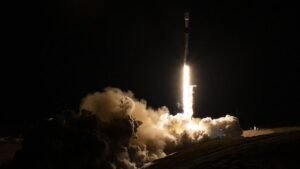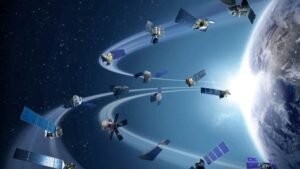How Do Satellites Stay In Orbit?
Satellites remain in orbit by achieving a balance between their high velocity and the gravitational pull of Earth. To understand how satellites stay in orbit, it’s essential to first consider how they get there. Satellites are launched into space using rockets that provide the necessary speed to overcome Earth’s gravitational pull. This speed, which must reach at least 25,039 mph (approximately 40,270 km/h), is critical for the satellite to exit the Earth’s atmosphere and enter into orbit. After the rocket reaches the desired altitude, it releases the satellite, which then continues to move at the velocity it had at the moment of detachment. This initial velocity is what allows the satellite to begin its journey around Earth.
But How do they stay in orbit? Sir Isaac Newton’s thought experiment offers a simple yet powerful explanation. Imagine a mountain so tall that its peak extends beyond the Earth’s atmosphere. If you throw a cricket ball horizontally from this peak, gravity will pull it downward, causing it to follow a curved path. If you throw it harder, the ball travels farther before hitting the ground. Now, if you throw it with enough speed, the ball’s path follows the curvature of the Earth, effectively entering an orbit. The ball continues to “fall” around the Earth, never hitting the ground due to its horizontal speed.
Process of Launching Satellites into Orbits
The process of putting satellites into orbit involves launching them on rockets. The satellite is placed atop a powerful rocket, which propels it away from the Earth and through the atmosphere. Once the rocket reaches the required altitude, it applies a sideways thrust, setting the satellite into motion at the correct speed. If the satellite’s speed is too low, it will fall back to Earth due to gravity’s centripetal pull.

If the speed is too high, the satellite will escape Earth’s orbit. Achieving the precise speed allows the satellite to stay in orbit, continuously falling around the Earth due to gravitational pull. Once in orbit, a satellite stays aloft by balancing two main forces: its velocity and Earth’s gravitational pull. The satellite’s velocity is the speed at which it moves in a straight line. In the vacuum of space, there is very little friction to slow it down, allowing it to maintain this high speed. Meanwhile, Earth’s gravity constantly pulls the satellite toward the planet.
The interaction between these forces means the satellite is essentially falling around Earth rather than directly back to it. This curved path creates a stable orbit, where the satellite keeps moving forward while being pulled downward by gravity. The gravitational pull of the Earth plays a continuous role in keeping the satellite in orbit. This pull provides the necessary centripetal force to keep the satellite on its curved path around the planet. Essentially, the satellite is in a state of free fall, moving forward while being pulled inward, creating a stable orbit.
Where Do Satellites Get placed?
Satellites can be placed in various types of orbits, each serving different purposes. In Low Earth Orbit (LEO), satellites are relatively close to Earth, between 160 and 2,000 kilometers above the surface. These satellites must travel at very high speeds to counteract the stronger gravitational pull at this altitude. Geostationary Orbit (GEO) satellites, on the other hand, are positioned much higher, approximately 35,786 kilometers above the equator. Satellites in GEO appear stationary relative to an observer on Earth because they orbit at the same rate that Earth rotates, requiring precise speed to match Earth’s 24-hour rotational period. Medium Earth Orbit (MEO) lies between LEO and GEO, often used for navigation systems like GPS.

Satellites carry fuel primarily for minor adjustments in their orbit, known as station-keeping, and for collision avoidance. Station-keeping involves making small corrections to the satellite’s path to counteract any deviations caused by gravitational influences from the moon, the sun, or Earth’s irregular shape. In addition, satellites may need to maneuver to avoid collisions with space debris or other satellites. However, fuel is not used to maintain the satellite’s speed in orbit, as the initial launch speed is sufficient for this purpose.
Why Don’t Satellites Crash Into Each Other?
Satellites usually don’t crash into each other because space agencies carefully track them and plan their paths to avoid collisions. When a satellite is launched, it’s put in an orbit that won’t cross paths with others. These organizations keep a close watch on all satellites and make adjustments if needed to prevent accidents. However, as more satellites are sent into space, the risk of crashes increases. In 2009, for example, a collision between the derelict Russian Kosmos 2251 spacecraft and the Iridium 33 communications satellite, resulted in the destruction of both satellites with more than 1800 debris approx. This rare event shows why it’s so important to keep monitoring and managing the satellites in space.
How Long Can Satellites Stay in Orbit?
For satellites in Low Earth Orbit (LEO), atmospheric drag, though minimal, can gradually slow them down, causing their orbits to decay over time. These satellites may eventually re-enter Earth’s atmosphere and burn up. In contrast, satellites in higher orbits, such as those in Geostationary Orbit (GEO), are less affected by atmospheric drag. Decommissioned satellites, particularly in GEO, are often moved to higher graveyard or disposal orbits where they remain out of the way of operational satellites. These graveyard orbits require minimal velocity to maintain position due to the weaker gravitational pull at that distance.
Bibliography
- Why Don’t Satellites Fall Out of the Sky? /National Environmental Satellite, Data, and Information Service
- The Collision of Iridium 33 and Cosmos 2251: The Shape of Things to Come/Nasa
- Satellites Explained /Nasa










